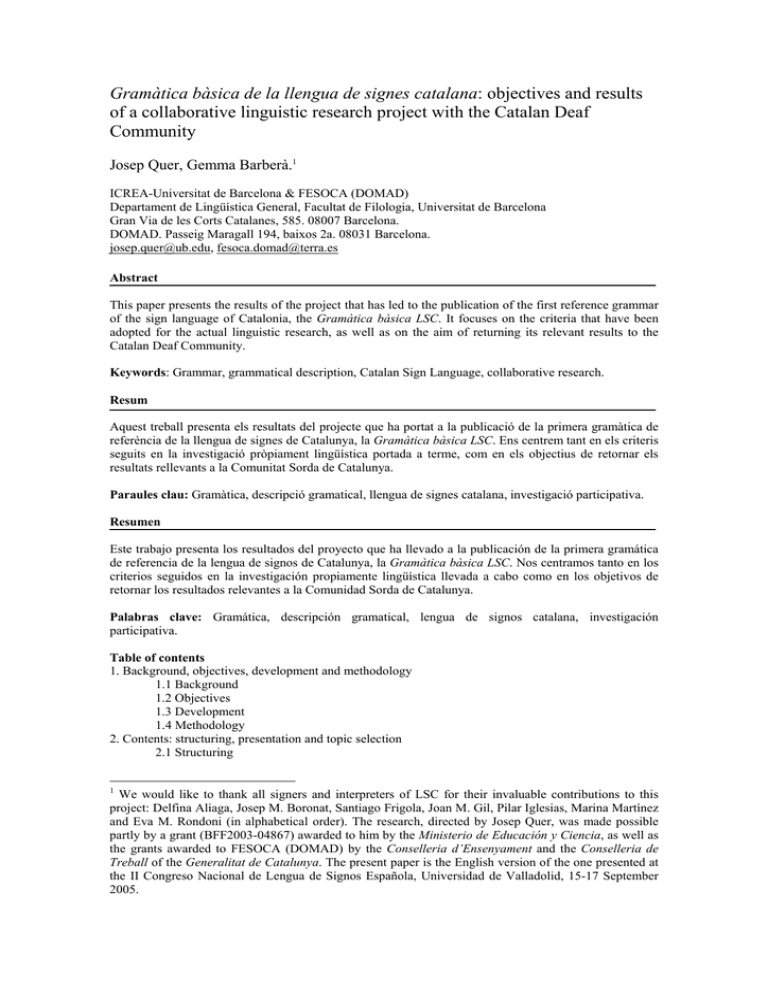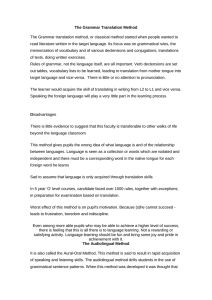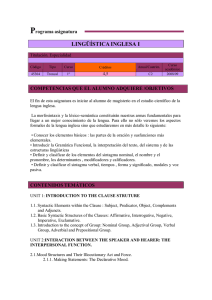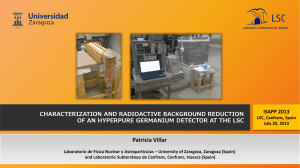Gramàtica bàsica de la llengua de signes catalana: objectives and
Anuncio

Gramàtica bàsica de la llengua de signes catalana: objectives and results of a collaborative linguistic research project with the Catalan Deaf Community Josep Quer, Gemma Barberà.1 ICREA-Universitat de Barcelona & FESOCA (DOMAD) Departament de Lingüística General, Facultat de Filologia, Universitat de Barcelona Gran Via de les Corts Catalanes, 585. 08007 Barcelona. DOMAD. Passeig Maragall 194, baixos 2a. 08031 Barcelona. josep.quer@ub.edu, fesoca.domad@terra.es Abstract This paper presents the results of the project that has led to the publication of the first reference grammar of the sign language of Catalonia, the Gramàtica bàsica LSC. It focuses on the criteria that have been adopted for the actual linguistic research, as well as on the aim of returning its relevant results to the Catalan Deaf Community. Keywords: Grammar, grammatical description, Catalan Sign Language, collaborative research. Resum Aquest treball presenta els resultats del projecte que ha portat a la publicació de la primera gramàtica de referència de la llengua de signes de Catalunya, la Gramàtica bàsica LSC. Ens centrem tant en els criteris seguits en la investigació pròpiament lingüística portada a terme, com en els objectius de retornar els resultats rellevants a la Comunitat Sorda de Catalunya. Paraules clau: Gramàtica, descripció gramatical, llengua de signes catalana, investigació participativa. Resumen Este trabajo presenta los resultados del proyecto que ha llevado a la publicación de la primera gramática de referencia de la lengua de signos de Catalunya, la Gramàtica bàsica LSC. Nos centramos tanto en los criterios seguidos en la investigación propiamente lingüística llevada a cabo como en los objetivos de retornar los resultados relevantes a la Comunidad Sorda de Catalunya. Palabras clave: Gramática, descripción gramatical, lengua de signos catalana, investigación participativa. Table of contents 1. Background, objectives, development and methodology 1.1 Background 1.2 Objectives 1.3 Development 1.4 Methodology 2. Contents: structuring, presentation and topic selection 2.1 Structuring 1 We would like to thank all signers and interpreters of LSC for their invaluable contributions to this project: Delfina Aliaga, Josep M. Boronat, Santiago Frigola, Joan M. Gil, Pilar Iglesias, Marina Martínez and Eva M. Rondoni (in alphabetical order). The research, directed by Josep Quer, was made possible partly by a grant (BFF2003-04867) awarded to him by the Ministerio de Educación y Ciencia, as well as the grants awarded to FESOCA (DOMAD) by the Conselleria d’Ensenyament and the Conselleria de Treball of the Generalitat de Catalunya. The present paper is the English version of the one presented at the II Congreso Nacional de Lengua de Signos Española, Universidad de Valladolid, 15-17 September 2005. 2.2 Presentation 2.3 Topic selection 3. Conclusions 4. Bibliographical references 1. Background, objectives, development and methodology 1.1 Background The project to create an elementary grammar of Catalan Sign Language (LSC) arose from a widely expressed desire by the Deaf Community in Catalonia to have at their disposal reference materials on the grammar of LSC. This vital need had been made explicit repeatedly in different educational domains: primary and secondary school teachers working in bilingual education programs for Deaf children, teachers of LSC as a second language, LSC interpreter trainers in Cicle Formatiu Superior and postgraduate LSC interpretation degrees, etc. Without the necessary tools for a Deaf child to reflect upon her first language, it is extremely difficult to tackle a second language, and it is even more difficult if this language is in a different modality (such as Catalan or Spanish, in the case of Catalan Deaf children). Besides this demand among LSC users and the Federació de Persones Sordes de Catalunya - FESOCA (Catalan Deaf Federation), there is a perception that reference works, such as a grammar or a dictionary, are needed in order to be able to defend the status of LSC as a natural language, differentiated from Spanish Sign Language (LSE). As these materials do not exist, comparative studies among the grammatical structures of the different languages cannot be undertaken and the lexical comparisons are restricted, in general, to an anecdotal level. The creation of these kind of materials can contribute to reinforcing the linguistic identity of the users’ community. As we are advancing now towards legal recognition of sign languages in Spain, the existence of such reference works should contribute to convincing the legislators, with arguments from the scientific domain, that sign languages are bona fide languages. Legal recognition of signing in a context in which the great majority of the civil society does not know the reality of sign languages and their users is certainly vital. From the field of linguistic research itself, any detailed study of some concrete aspect of a language needs a global view on this language. Grammar phenomena cannot generally be studied in isolation: usually in any particular phenomenon many factors pertaining to other levels of linguistic description different from that which concerns us specifically, come together directly or indirectly. Therefore, a global characterization of the grammar of a language can support partial and detailed research on this language, which will as well shed new light on the whole. With all these previous considerations in mind, we studied the possibility of developing an LSC elementary grammar, within the collaborative framework between FESOCA and the Departament de Lingüística General of the Universitat de Barcelona (UB) established in January 2003. 1.2 Objectives Taking into account all the needs pointed out in the previous section, we set ourselves the following goals: (a) To carry out a grammatical description that should cover the most important aspects of LSC. (b) To disseminate the main results of this research in a publication that would be accessible to: a. Primary and secondary school teachers with students who use LSC. b. Deaf students in secondary education. c. Teachers and students of Cicle Formatiu Superior and postgraduate courses specialising in LSC interpretation. d. Teachers and learners of LSC as a second language. e. Researchers. f. LSC users with some knowledge of grammar. (c) To adopt a system of collaborative research, so that the signers involved would get trained in the process itself. (d) To consolidate and broaden the metalinguistic discourse in LSC on sign language, as well as a basic linguistic terminology. (e) To establish the basis for future partial investigations into more specific areas of LSC grammar. For these reasons, and in order to reach these objectives, from the very beginning it seemed clear to us that the grammar had to be presented in the same language that was object of study, that is to say in LSC. The signed discourse would appear with the corresponding translations into Catalan, Spanish, and English, in order to reach the widest range of potential users. At the same time, the linguistic explanation had to aim at a maximum of simplicity, although a basic knowledge of grammar is needed to get a complete understanding of the contents. 1.3 Development The project finally set out with the help of a grant of the Conselleria d'Ensenyament and the Conselleria de Treball de la Generalitat de Catalunya awarded to DOMAD (Departament de Documentació i d'Elaboració de Materials Didàctics of the FESOCA). Its coordinator, Eva M. Rondoni, was responsible for the technical direction of the project; and the role of scientific director was taken by Josep Quer, ICREA research professor affiliated to the Universitat de Barcelona. The collaborative research between the Departament de Lingüística General of the Universitat de Barcelona and FESOCA had set out in April 2002, when the group GRIN (Gramàtica i Interpretació de Llengua de Signes) was established. GRIN is formed by eight Deaf people and interpreters, including the technical and the scientific directors already mentioned. The grants allowed FESOCA (DOMAD) to hire some members of GRIN on a part-time basis, although not all the worked hours were remunerated. The DOMAD (FESOCA) employees were in charge of the CD-ROM edition and design, as well as the technical aspects, such as shooting, editing and production. The process was planned in the following phases, that were not necessarily consecutive: (i) Compilation of grammatical observations on LSC from language training materials; consultation of grammars and materials of other sign languages (cf. references section). (ii) Establishing of a provisional table of contents. (iii) Developing and writing the contents of each topic on the basis of the discussion of the observations gathered by the signers, comparison of specific data, etc. (iv) Establishing the grammar terms in LSC necessary for the signed discourse. (v) Signing and videotaping the contents of each topic. (vi) Design and editing. (vii) Revision of the signed discourse. (viii) Preparation of the definitive version, together with the translations into Catalan, Spanish and English. The project began in June 2003 and finished two years later, in June 2005, when the work was publicly presented at the Institut d'Estudis Catalans. It is important to remark that one of the phases that required a greater time effort was the videotaping of the grammatical explanations. Although it is obvious that a sign language grammar had to be presented primarily in sign and therefore in video format (DVD or CD-ROM), we did not have examples from other languages, with the exception of Aprendamos LSE (FAAS, 1996) and the grammar of the Dutch Sign Language by Bos & Kuiken (2002). The first example did not attain the level of detail that we had in mind and was produced in analogue video. However, the second case did correspond to what we wanted to achieve. Therefore, both at a level of contents and interface, its analysis was especially useful to us in order to define the format, the presentation and the structuring of the grammar contents. 1.4 Methodology During the research phase aiming to determine the contents of the project, the grammar observations that the participants gave from their professional experience, as teachers or LSC interpreters, were taken into account, as well as many observations considered necessary to complete the description of a certain phenomenon. These observations were compared with the existing ones in the few published teaching materials on LSC (Aprenem I/II, Els Genís i la Sanitat, Els Genís i l'Educació), both in the data gathered in those publications and in the grammatical comments that appear in them sporadically. In more than one case this process led to modifications and almost always to a more complete description of the studied phenomenon. Given the limited amount of linguistic research in LSC, we decided to use the grammatical descriptions of other sign languages, like LSE or ASL. The discussion of data from other languages often led to identify the structures or the corresponding forms in LSC. We always tried to distinguish what is characteristic of LSC from what can be a result of the linguistic contact with LSE, although this task is especially difficult because of the little existing documentation in the two sign languages involved. As in any linguistic study, the accumulated knowledge on other languages -either typologically distant or close- allowed us to discover aspects that would otherwise have gone unnoticed. The definition of the contents has always been descriptive, not prescriptive. Thus, it was deemed necessary to respect any variation where it occurred, and in some cases variants that are not only used by a single signer, but by different ones, were introduced. We wanted to avoid a prescriptive aproach, which would be unacceptable due to the lack of a more extensive and deep study of the present state of the language that would take into account generational, geographic, and register variables. In any case, the offered description always relies on linguistic theory: although every effort has been made to avoid using theoretical apparatus in the final form, theory served as a heuristic tool. We tried to restrict the use of grammar concepts to the essential minimum, always ensuring that the explanation of the concept is included in the characterization of the phenomenon and exemplified clearly. Nevertheless, we took for granted some elementary concepts, such as "verb", "subject" or "question". 2. Contents: structuring, presentation and topic selection 2.1 Structuring Since in this first work of LSC grammar description we could not set ourselves as a goal an exhaustive characterization of all aspects of the grammar, we were compelled to select the topics that we considered most relevant. We relied on the structure of already existing descriptions, but we modified and completed them according to our own criteria and the goals that we had defined. The result is ten topic sections which try to cover different levels of grammatical analysis in a balanced way: phonetics, phonology, morphology, syntax and semantics-pragmatics. We put aside strictly lexical aspects, although observations that belong to this area are sometimes brought in because of their relevance in the exposition of the topic. Nevertheless, the treatment of the topics does not reflect a strict separation of the different levels of analysis, but rather the descriptions of different grammatical levels are combined, for example morphology with syntax, or syntax with semantics. Besides these ten topics, there is a general introduction to this grammar and to sign languages in general. It is not meant as a pedagogical grammar method which is organised in a progressive fashion with the goal to learn the language. Nevertheless, because of the general objectives of this work, it can be used as a support material to study it, either as L1 or L2. Although the topics do not appear organized in a table of contents, a minimal underlying hierarchical structure can be recognised, that goes from the study of the smallest units of the language (phonology) to the largest ones (syntax in connection with pragmatics and semantics). 2.2 Presentation As we have indicated above, the signed explanation of the theory was done with the minimum of grammatical terminology, so that the meaning of the concepts is expounded in the explanation itself. Each topic is introduced in its generality and then its partial aspects are addressed. The structure of the topic is reflected in the index that appears to the left of the screen, where the sections and subsections of the topic are located. By clicking on any of them, the corresponding explanation appears. Special emphasis was put on the explanation being accompanied by numerous examples that should allow a better understanding of its content, while at the same time the LSC phenomenon that is being described can be observed. The signed explanation appears with the corresponding written translation into Catalan, Spanish and English. In the text, the important grammatical terms are highlighted in bold print - in that case the words are included in the grammar's glossary section. By clicking on the term a window with the corresponding sign opens, so that the identification of these grammar terms is given in LSC. As an alternative option, all the signs of the glossary can be viewed by clicking on the corresponding icon. In the translation of the signed explanation we chose not to use glosses for several reasons: firstly, because the requirement of previous knowledge of the glossed conventions could make the grammar partially inaccessible to people who did not know them; secondly, because in many aspects the glosses are not very precise; thirdly, because unified conventions for the same sign or the same grammatical marking usually do not exist within the language. Therefore, we have exclusively used spoken language translation for sentential examples and isolated signs, which always appear in quotation marks. The chosen translation is in some cases one possibility of many. The translation then does not correspond to the traditional gloss, but rather to the meaning of the sign in that specific sentence. Grammatical phenomena are not isolated compartments, and in the text devoted to one topic more than once reference is made to another one because some relevant relationship exists. This is done by means of a hyperlink in the written text and is graphically reflected by underlining the corresponding term. The working screen is organized as follows: in the upper area we find the different sections that constitute the grammar. Upon clicking any one of them, one accesses the first page of the chapter selected. On the left side of the screen we find the index for the thematic section selected. As each thematic section is divided into subsections, direct access to each one is possible simply by clicking on it. On the left bottom of the page one finds the Introduction and Glossary buttons. 2.3 Topic selection The index of the grammar is as follows: 1. Basic Components 2. Number 3. Time 4. Aspect 5. Classifiers 6. Agreement 7. Basic Sign Order 8. Localization 9. Affirmation, Negation, Imperative 10. Interrogation The first topic is the one concerning phonological description of the signs. The explanation includes manual components (handshape, location, movement, orientation) and non-manuals (facial expression, torso movement, head position and/or movement, mouth gesture and mouthing). The three next topics focus mainly on morphological aspects: number, time and aspect. Within the number section, the phenomena of reduplication in nouns, classifiers and verbs, as well as numeral incorporation are analyzed. Attention is also given to the nonmanual markers that often contribute degree or quantity information. By thematic affinity, the forms used for enumeration are also included in this chapter. The section featuring the expression of temporal notions analyzes the morphological use of space in relation to the three axes for time reference (basic or chronological, anaphoric and sequential), in combination with the lexical means available. Next, the basic markers of the main aspect types are described (continuative and durative, habitual, iterative, perfective and perfect), both in its manual and non-manual instantiations and in its analytical lexical expression. The following two topics focus on the morphological, syntactic and lexical levels of the grammar. A whole thematic section is devoted to the study of LSC classifiers. We attempted to make a relatively exhaustive description of the different kinds of semantic classifiers. The form of classifier handshapes can be accessed from the text of the translations: they can be examined in a static drawing that pops up after clicking on the relevant item. We paid less attention to descriptive and handling classifiers, as they constitute a much more open class. Next, a whole section deals with verbal agreement and how agreeing verbs behave depending on this agreement. As it has already been established in many other sign languages, a distinction is established between grammatical or syntactic agreement (directional verbs, both regular and backwards) and locative agreement (spatial verbs). Plain or invariable verbs are those that do not present any kind of agreement. We also describe the behaviour of the agreement auxiliary sign. Due to the thematic relatedness, we briefly present in this chapter the phenomenon of pronominal ellipsis and comparative structures. Another topic section explains, although briefly, the general principles that can influence sign order, which is determined by syntactic as well as information structure reasons. Simultaneity at a syntactic level is also mentioned. We devoted a whole section to localization, both descriptive (topographic) and nondescriptive (grammatical), and to its anaphoric reference use, paying attention to the different resources available to locate entities in the signing space. The last two sections focus on sentence modality. Firstly, we described lexical and nonmanual resources for the expression of affirmative and negative statements and orders (imperative and its equivalents). Secondly, we concentrated on yes/no and whinterrogatives and we described their non-manual marker, as well manual elements used in them. Within the first group we also included alternative interrogatives. Last, we included a discussion of "rhetorical questions", a type of focussing strategy consisting in a wh-question and answer pair with specific non-manual markers. 3. Conclusions In this paper we have discussed what objectives were initially taken into consideration in the development of the first LSC grammar, how it was planned and executed and what methods were followed in order to become a real collaborative work with the Deaf Community in Catalonia. At different levels, LSC experts who participated in the development of the contents contributed in some way or other to the final result, and the discussion of the contents itself constituted a learning process. Now it remains to verify what the impact of this work will be among the different kinds of potential users. In any case, we conceived this basic grammar not as an endpoint but as a platform for further research on phenomena that we have only been able to scratch the surface of or that we have not even been able to include. 4. Bibliographical references AA.VV. (2001). Apuntes de Lingüística de la Lengua de Signos Española. Madrid: CNSE (Confederación Estatal de Personas Sordas de España). Bos, H. & F. Kuiken, (2002). Basisgrammatica Nederlandse Gebarentaal. Amsterdam/Bunnik: University of Amsterdam/Dutch Sign Language Centre. CNSE, (1998). Signar, enseña lengua de signos española. Nivel inicial. Madrid: CNSE (Confederación Estatal de Personas Sordas de España). CNSE, (1999). Signar, enseña lengua de signos española. Nivel intermedio. Madrid: CNSE (Confederación Estatal de Personas Sordas de España). DOMAD, (2002). Els Genís i l’educació. Barcelona: DOMAD (FESOCA). DOMAD, (2002). Els Genís i la sanitat. Barcelona: DOMAD (FESOCA). FAAS, (1996). Aprendamos LSE. Granada: FAAS (Federación Andaluza de Asociaciones de Sordos). Herrero, Á. et al., (2000). Signolingüística. Introducción a la lingüística de la LSE. Valencia: Fundación FESORD C.V. (Federación de Personas Sordas de la Comunidad Valenciana) Humphries, T., C. Padden & T. O’Rourke, (1991). A Basic Course in American Sign Language. Silver Spring, MD: T.J. Publishers. ILLESCAT, (1999). Aprenem LSC! Llibre 1. Barcelona: ILLESCAT (Centre d’Estudis de la Llengua de Signes Catalana). ILLESCAT, (2000). Aprenem LSC! Llibre 2. Barcelona: ILLESCAT (Centre d’Estudis de la Llengua de Signes Catalana). Quer, J. (scientific direction), E.M. Rondoni (technical direction) & GRIN. (2005). Gramàtica bàsica LSC. Barcelona: DOMAD (FESOCA). ISBN: 84-932511-9-4. Veyra, M. & B. Gallardo, coord., (2002). Estudios lingüísticos sobre la Lengua de Signos Española. València: Universitat de València.


